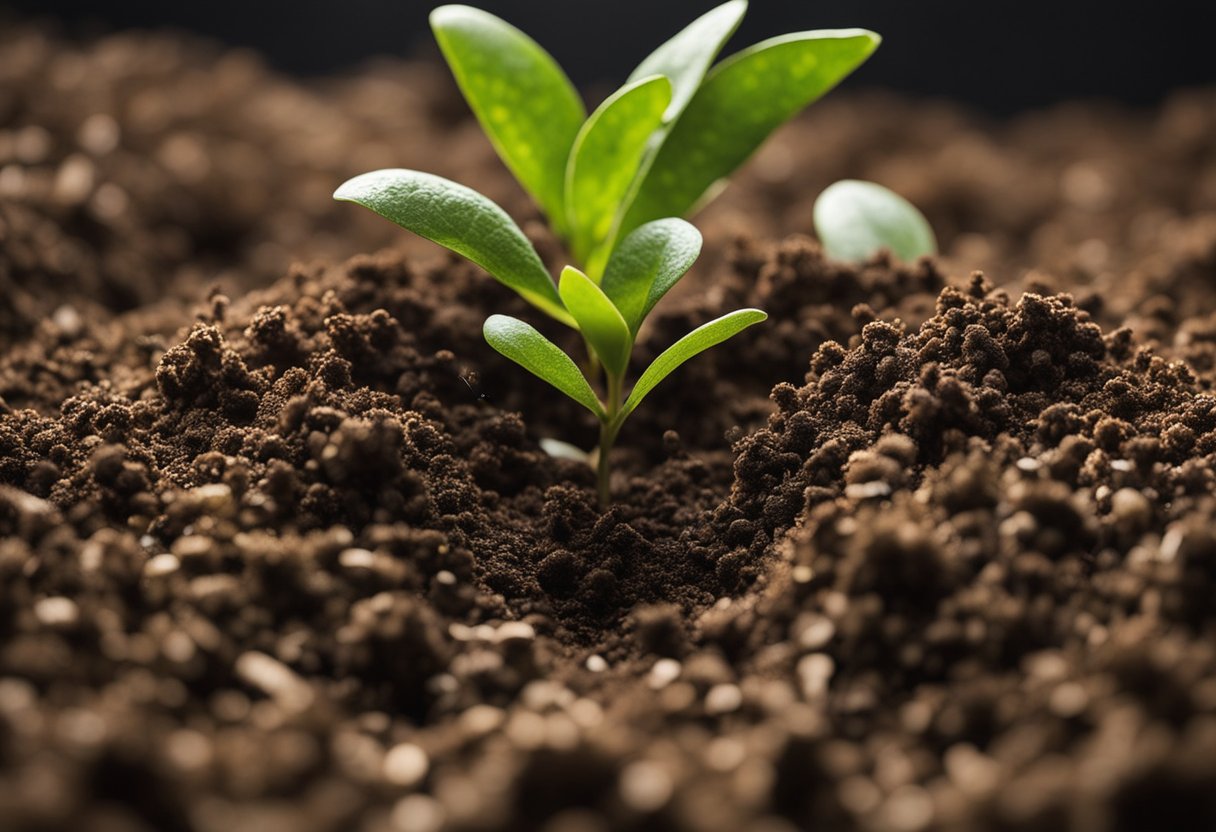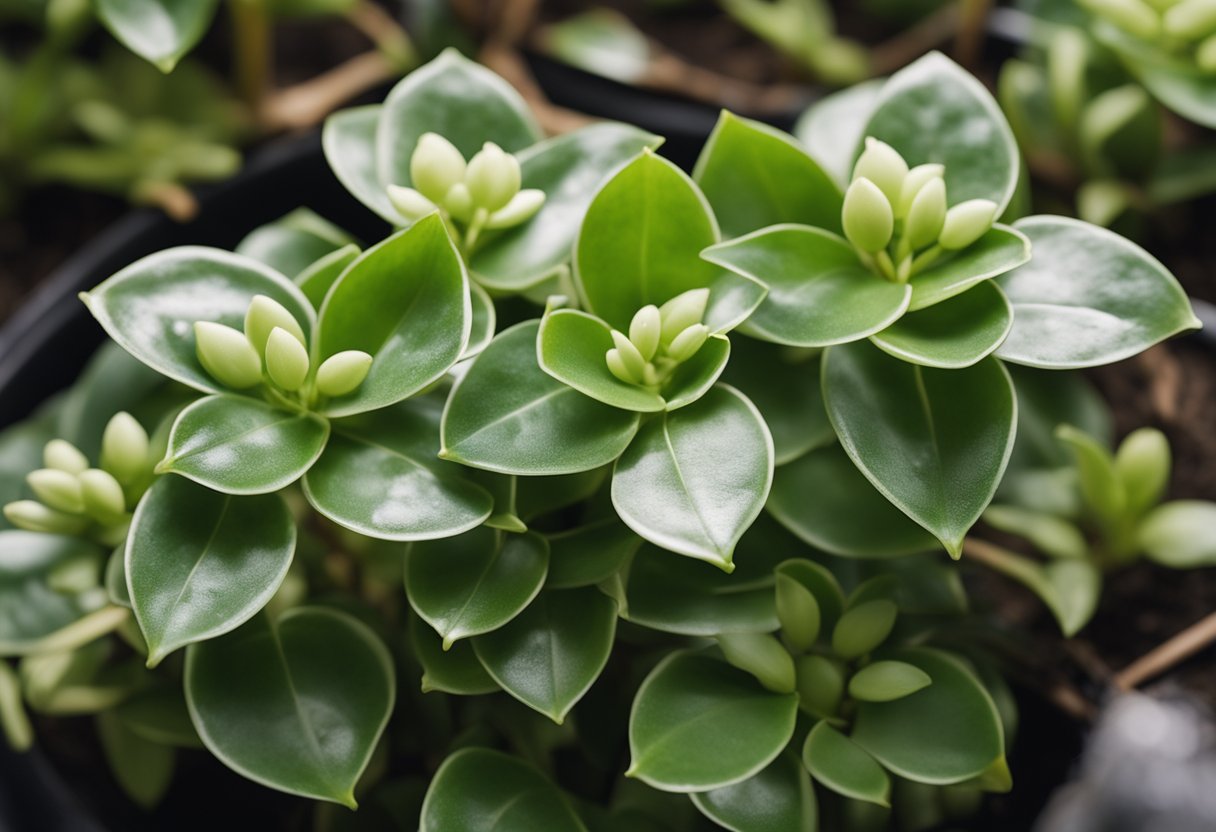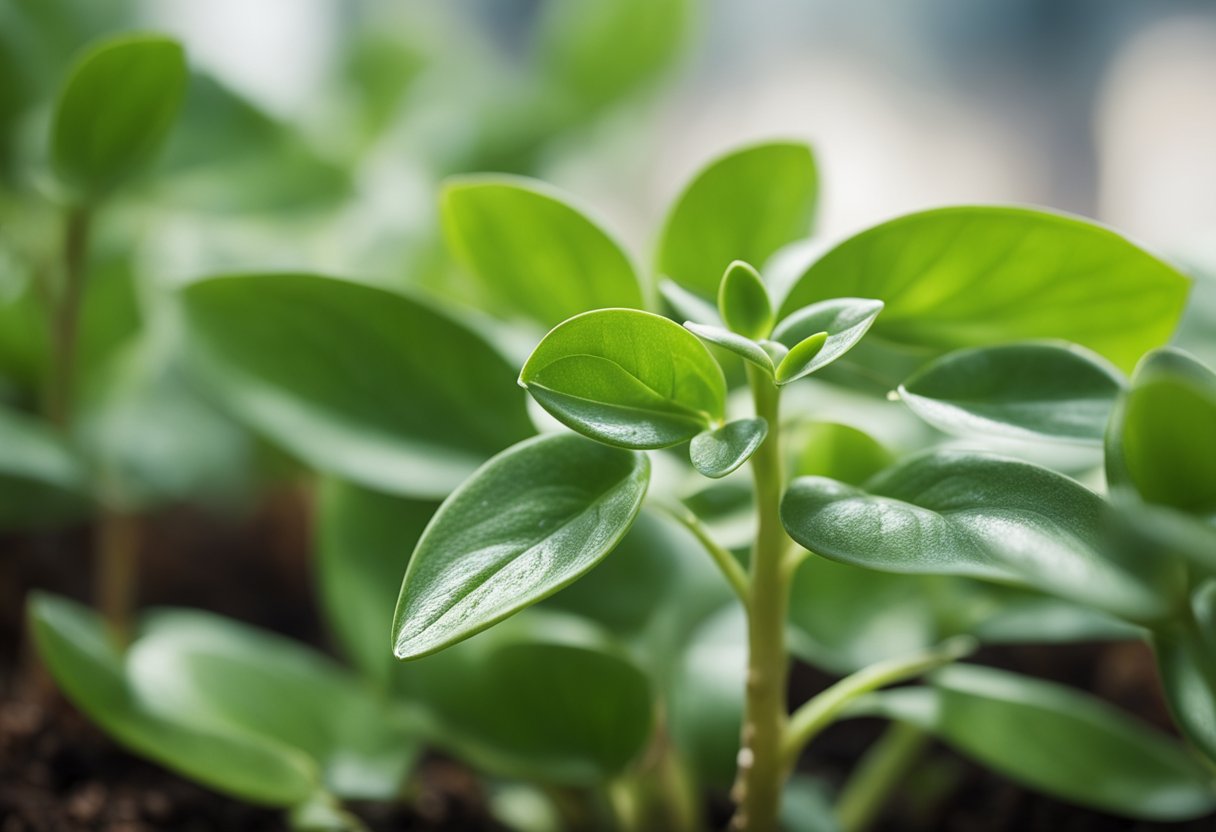Best Soil for Hoya: A Comprehensive Guide for Healthy Growth
Hoya plants, also known as wax plants, are popular houseplants due to their stunning foliage and fragrant flowers. These plants are relatively easy to care for, but one of the most important factors to consider is the type of soil they are planted in. The right soil can help ensure that your Hoya plant thrives and produces healthy foliage and blooms.
This post may contain affiliate links, which means I’ll receive a commission if you purchase through my link, at no extra cost to you. Please read full disclosure here.

When it comes to selecting the best soil for Hoya plants, it is important to keep in mind that these plants are epiphytes, meaning they grow on the surface of tree trunks and other plants in the wild. As a result, they do not need a rich growing environment and can adapt to growing in numerous types of soil. However, it is still important to choose a soil that provides adequate drainage and aeration to prevent root rot and other issues.
There are several types of soil mixes that are suitable for Hoya plants, including mixes that contain peat moss, perlite, and other organic materials. The ideal soil mix will depend on factors such as the specific type of Hoya plant you have, the size of the pot, and the growing conditions in your home. By selecting the right soil and providing proper care, you can help your Hoya plant thrive and add beauty to your home.
Understanding Hoya Plants

Hoya plants, also known as wax plants, are a popular choice for houseplant enthusiasts due to their waxy leaves and low-maintenance nature. These plants are native to Asia and Australia and are part of the epiphyte family, meaning they grow on other plants rather than in soil.
Hoya plants are vines that can grow up to several feet long, making them a great choice for hanging baskets or trellises. They require bright, indirect light and moderate humidity to thrive. In fact, hoya plants are sometimes referred to as “porcelain flowers” due to their delicate, intricate blooms.
There are many varieties of hoya plants, each with their own unique characteristics. Some of the most common varieties include the carnosa and kerrii, both of which are known for their waxy leaves and beautiful blooms.
When it comes to soil, hoya plants prefer a well-draining mix that is high in organic matter. A mix of potting soil and perlite is a popular choice, with a pH of around 6.5. Adding an inch or two of sphagnum peat to the soil can also help increase acidity and provide nutrients to the plant.
In summary, hoya plants are a great choice for those looking for a low-maintenance, beautiful houseplant. With their waxy leaves, delicate blooms, and ability to grow as vines, they are sure to add a touch of elegance to any space.
Optimal Soil Conditions for Hoya

Hoya plants require well-draining soil to prevent root rot. The soil mix should be able to provide good drainage while retaining enough moisture for the plant. A mix of peat moss, sand, and perlite is a good option for Hoya plants. The sphagnum peat is one of the best options for Hoya plants. Adding an inch or two of sphagnum peat to the soil can help regulate pH levels and increase acidity while adding nutrients to the humus.
Hoyas prefer slightly acidic to neutral soil with a pH ranging from 6.0 to 7.0. It is important to ensure that the soil you choose falls within this range to promote optimal growth. Acidic fertilizers are another great way to increase acidity while adding nutrients to the humus.
The best soil for Hoya plants is airy and lightweight soil with good drainage. A good soil mix for Hoya plants should contain organic matter such as compost, charcoal, or vermiculite. A mix of potting soil and perlite is also a good option. This mix should contain 50% potting soil and 50% perlite. Another suitable option is a cactus or succulent mix that contains sand, pumice, and lime.
Pumice soil amendment can also be added to the soil mix to improve aeration and drainage. It is important to note that Hoya plants do not like to sit in wet soil, so a well-draining soil mix is crucial for their growth. Hoya soil mix can also be used, which is specifically formulated for Hoya plants.
In summary, the best soil for Hoya plants is a well-draining soil mix that contains organic matter, such as peat moss, compost, or vermiculite. A mix of potting soil and perlite or a cactus or succulent mix that contains sand, pumice, and lime is also a good option. Adding pumice soil amendment can improve aeration and drainage. It is important to ensure that the soil is slightly acidic to neutral with a pH ranging from 6.0 to 7.0.
Potting and Repotting Hoya
When it comes to potting and repotting Hoya plants, it is important to choose the right type of pot and soil mix. Hoya plants prefer to be slightly root-bound, so it is best to choose a pot that is just slightly larger than the current one.
Terra cotta pots are a great option for Hoya plants, as they allow for good drainage and air circulation. Hanging baskets and trellises are also popular options, as they allow the vines to trail and climb. When selecting a container, make sure it has drainage holes to prevent water from sitting in the bottom of the pot.
When repotting a Hoya plant, it is important to gently loosen the root ball and remove any dead or damaged roots. Use a well-draining soil mix that contains peat moss, perlite, and vermiculite. Avoid using heavy, clay-based soils that can retain too much moisture and cause root rot.
To repot a Hoya plant, carefully remove it from its current pot and gently loosen the root ball. Place a layer of soil in the bottom of the new pot and position the plant in the center. Fill in the sides with soil, making sure to leave a small gap between the soil and the top of the pot to allow for watering.
After repotting, water the plant thoroughly and place it in a bright, indirect light. Avoid fertilizing for the first few weeks to allow the plant to adjust to its new environment. With proper care and maintenance, a Hoya plant can thrive in its new pot for several years.
Light and Temperature Requirements
Hoya plants are native to tropical and subtropical regions of Asia and require specific light and temperature conditions to thrive. These plants prefer bright, indirect sunlight, which means that they should be placed in a location that receives plenty of natural light but not direct sunlight. Direct sunlight can cause the leaves to burn, while too little light can result in stunted growth and poor flowering.
Hoya plants also prefer warm temperatures, with the ideal range being between 60-85°F. Temperatures below 50°F can cause damage to the plant, while temperatures above 90°F can cause the leaves to wilt and dry out. It is important to keep the plant away from drafts and sudden temperature changes, which can also cause damage.
To ensure that your Hoya plant receives the appropriate amount of light, it is recommended to place it near a bright window that receives indirect sunlight. If the plant is not receiving enough light, you can supplement it with artificial light using a grow light. It is important to note that different Hoya species may have varying light requirements, so it is best to research the specific needs of your plant.
In terms of temperature, it is important to keep your Hoya plant in a warm and stable environment. If you live in a cooler climate, you may need to use a space heater to maintain the appropriate temperature. Conversely, if you live in a warmer climate, you may need to use air conditioning or a fan to keep the plant cool.
Overall, providing your Hoya plant with the appropriate light and temperature conditions is essential for its growth and health. By following these guidelines, you can ensure that your plant thrives and produces beautiful blooms.
Watering and Humidity Needs
Hoyas are known to be relatively low maintenance plants and do not require frequent watering. Overwatering can lead to root rot, so it’s important to let the soil dry out between watering. The frequency of watering will depend on the type of soil, the size of the pot, and the environmental conditions.
When it comes to watering, it’s important to remember that Hoyas are succulent plants and store water in their leaves and stems. They prefer to be slightly underwatered rather than overwatered. The soil should be allowed to dry out about halfway down the pot before watering again.
In terms of humidity, Hoyas prefer moderate to high humidity levels. They are native to tropical regions and thrive in moist environments. If the air is too dry, the leaves may become crispy and brown at the edges. To increase humidity, you can mist the leaves with water or place a tray of water near the plant.
It’s important to note that different types of Hoyas may have slightly different watering and humidity needs. For example, Hoyas with thicker leaves, like Hoya carnosa, can handle drier conditions than Hoyas with thinner leaves, like Hoya kerrii. It’s important to research the specific needs of your Hoya plant to ensure it thrives in its environment.
Overall, when it comes to watering and humidity needs, it’s important to strike a balance between not overwatering and providing enough moisture for the plant to thrive. With the right care, your Hoya plant can live for many years and produce beautiful blooms.
Nutrition and Fertilizer
Hoya plants require little extra fertilizing to maintain healthy and vigorous growth, but light fertilizing during the period of active growth in the spring and summer is helpful. The best time to fertilize is when the plant is actively growing, and the soil is moist.
When it comes to selecting a fertilizer, it is important to choose one that is balanced and provides a range of nutrients. A balanced fertilizer contains equal amounts of nitrogen, phosphorus, and potassium. Nitrogen is essential for leaf growth, phosphorus for root growth, and potassium for overall plant health.
There are many types of fertilizers available for Hoya plants, including organic and synthetic options. Organic fertilizers, such as compost, manure, and bone meal, provide a slow release of nutrients to the plant. Synthetic fertilizers, on the other hand, provide a quick release of nutrients and are available in liquid or granular form.
Coffee grounds are a popular organic fertilizer for Hoya plants. They are rich in nitrogen and other essential nutrients that can help promote healthy growth. Simply mix the coffee grounds into the soil around the base of the plant, or sprinkle them on top of the soil and water in.
It is important to note that over-fertilization can be harmful to Hoya plants. Too much fertilizer can lead to salt buildup in the soil, which can damage the roots and cause the plant to wilt. Always follow the manufacturer’s instructions when applying fertilizer, and never exceed the recommended dosage.
Common Problems and Solutions
Hoya plants are generally easy to care for, but they can still experience some common problems. Here are some of the most common problems and solutions for Hoya plants:
Root Rot
Root rot is a common problem for Hoya plants. It is caused by overwatering and poor drainage. When the roots of the plant are constantly wet, they can become damaged and begin to rot. To prevent root rot, make sure that the soil is well-draining and that the plant is not sitting in standing water. If root rot has already set in, you may need to repot the plant in fresh soil and remove any damaged roots.
Pests
Hoya plants can be susceptible to pests such as mealybugs, aphids, and scale. These pests can cause yellow or white spots on the leaves of the plant, and can also cause wilting and other problems. To get rid of pests, you can use neem oil or other insecticides. It is important to treat the plant as soon as you notice the pests, as they can quickly spread and cause more damage.
Fungal Infections
Fungal infections can also be a problem for Hoya plants, especially if the plant is overwatered or if the humidity levels are too high. Fungal infections can cause brown spots on the leaves, as well as wilting and other problems. To prevent fungal infections, make sure that the soil is well-draining and that the plant is not sitting in standing water. You can also use a fungicide to treat the plant if necessary.
Overall, Hoya plants are relatively easy to care for, but they can still experience some common problems. By following the tips above, you can help prevent and treat these problems, and keep your Hoya plant healthy and thriving.
Propagation of Hoya Plants
Hoya plants are easy to propagate and make great gifts for friends and family. There are several methods for propagating Hoya plants, including stem cuttings and layering.
Stem cuttings are one of the most popular methods for propagating Hoya plants. To do this, cut a stem from the plant just below a node and remove any leaves from the bottom half of the cutting. Then, dip the cut end of the stem in rooting hormone and plant it in a well-draining soil mix. Keep the soil moist and in a warm, humid environment until roots have formed.
Another method for propagating Hoya plants is through layering. To do this, bend a stem of the plant down to the soil and secure it in place with a bent wire or a U-shaped staple. Then, cover the area where the stem touches the soil with a layer of soil. The stem will begin to form roots and can be cut from the parent plant once it has established itself.
It’s important to note that Hoya plants are slow-growing and can take several months to establish roots. However, once they have established, they are relatively easy to care for and can produce beautiful flowers.
Overall, Hoya plants are a great addition to any home or garden. With their easy propagation methods and beautiful flowers, they are a great choice for both beginner and experienced gardeners alike.
Varieties of Hoya Plants
Hoya plants come in a variety of species, each with its own unique characteristics. The most common Hoya plants are the Hoya carnosa and the Hoya pubicalyx. The Hoya carnosa has waxy leaves and produces clusters of pink or white flowers. The Hoya pubicalyx, on the other hand, has dark green leaves and produces clusters of red or pink flowers.
Other popular varieties of Hoya plants include the Hoya kerrii, which is also known as the sweetheart Hoya due to its heart-shaped leaves. This plant produces clusters of pink or white flowers. The Hoya lacunosa has small, succulent-like leaves and produces clusters of white or pink flowers. The Hoya australis is a trailing plant that produces clusters of white or pink flowers.
Hoya plants are also known for their unique flower colors. Some varieties produce flowers in shades of red, such as the Hoya erythrostemma and the Hoya pubicalyx red buttons. Other varieties produce flowers in shades of yellow, such as the Hoya bella and the Hoya serpens. White flowers are also common among Hoya plants, such as the Hoya carnosa and the Hoya kerrii. Pink flowers can be found in several varieties, including the Hoya lacunosa and the Hoya australis.
Overall, Hoya plants offer a wide range of varieties and flower colors, making them a popular choice among plant enthusiasts. When choosing the best soil for Hoya plants, it is important to consider the specific needs of each variety to ensure optimal growth and health.
Final Thoughts on Hoya Care
Taking care of Hoya plants is relatively easy, and with the right soil, they can thrive. As epiphytes, hoyas don’t need a rich growing environment and can grow on the surface of tree trunks and other plants in the wild.
When it comes to soil, hoyas aren’t picky, and they can grow in a variety of soil types. However, it’s essential to ensure that the soil is well-draining to prevent waterlogging, which can lead to root rot. Additionally, most Hoya varieties prefer slightly acidic soil with a pH from 6.1 to 7.3.
When planting hoyas, it’s best to use a well-draining soil mix that contains a combination of perlite and pumice. This mixture provides the nutrients the plant needs while also providing drainage to keep the roots healthy.
Pruning is an essential part of Hoya care, and it’s best to prune the plant in the spring or summer when it’s actively growing. Pruning helps to keep the plant compact and encourages new growth.
In terms of the environment, hoyas prefer bright, indirect sunlight and can tolerate some drought. It’s essential to keep the plant away from direct sunlight to avoid leaf scorch. Additionally, it’s best to avoid placing the plant in a drafty area or near a heating or cooling vent.
Overall, with the right soil, pruning, and environment, Hoya plants can be a beautiful addition to any home or garden.